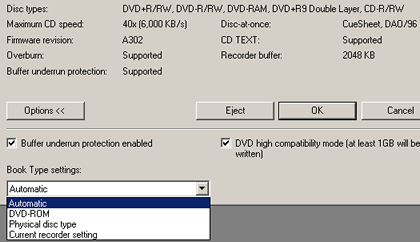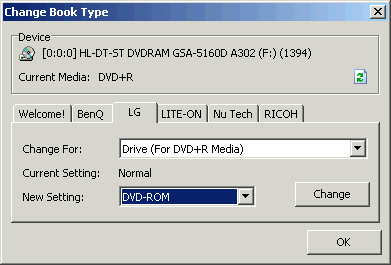LG GSA-5160D
22. BookType Setting
Review Pages
2. Transfer Rate Reading Tests
3. CD Error Correction Tests
4. DVD Error Correction Tests
5. Protected Disc Tests
6. DAE Tests
7. Protected AudioCDs
8. CD Recording Tests
9. Writing Quality Tests - Clover System Tests
10. Writing Quality Tests - C1 / C2 Error Measurements
11. DVD Recording Tests
12. CDSpeed/PlexTools Scans - Page 1
13. CDSpeed/PlexTools Scans - Page 2
14. CDSpeed/PlexTools Scans - Page 3
15. CDSpeed/PlexTools Scans - Page 4
16. CDSpeed/PlexTools Scans - Page 5
17. CDSpeed/PlexTools Scans - Page 6
18. CDSpeed/PlexTools Scans - Page 7
19. DVD+R DL - Page 1
20. DVD+R DL - Page 2
21. DVD-RAM Tests
22. BookType Setting
23. Conclusion
The drive supports the Booktype function, through the Nero Properties of the drive. By default, the booktype is set to Automatic ( DVD-ROM) but it can be switched to any type to fit the users demands, as we can see in the image below taken from the drives properties.

As follows, we also used two other softwares to check the booktype's settings with this drive.
Nero CD DVD Speed
The drive can adjust the booktype only for the DVD+R DL and DVD+R media. The DVD+RW format is set by default to DVD-ROM for better compatibility.

And as the software prompts here, the booktype is successfully changed.

DVD Decrypter
A click away from the booktype change...

DVD Decrypter confirms the booktype support...

Review Pages
2. Transfer Rate Reading Tests
3. CD Error Correction Tests
4. DVD Error Correction Tests
5. Protected Disc Tests
6. DAE Tests
7. Protected AudioCDs
8. CD Recording Tests
9. Writing Quality Tests - Clover System Tests
10. Writing Quality Tests - C1 / C2 Error Measurements
11. DVD Recording Tests
12. CDSpeed/PlexTools Scans - Page 1
13. CDSpeed/PlexTools Scans - Page 2
14. CDSpeed/PlexTools Scans - Page 3
15. CDSpeed/PlexTools Scans - Page 4
16. CDSpeed/PlexTools Scans - Page 5
17. CDSpeed/PlexTools Scans - Page 6
18. CDSpeed/PlexTools Scans - Page 7
19. DVD+R DL - Page 1
20. DVD+R DL - Page 2
21. DVD-RAM Tests
22. BookType Setting
23. Conclusion





















